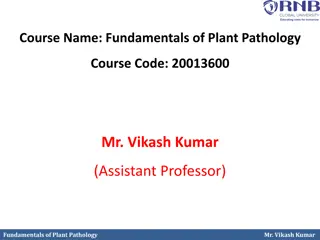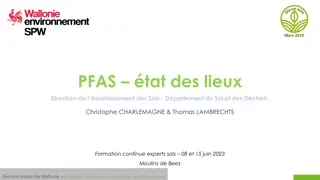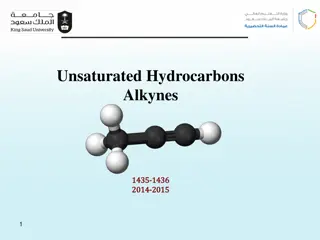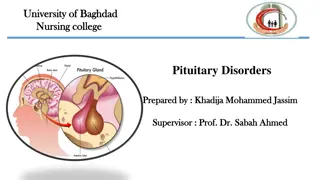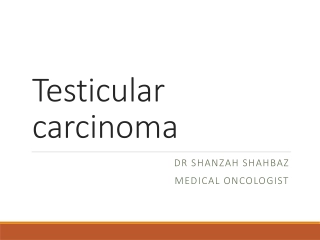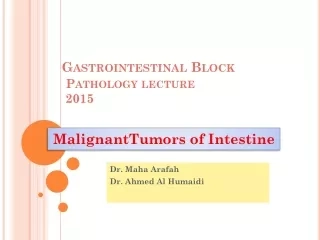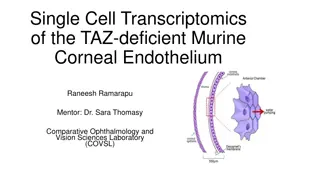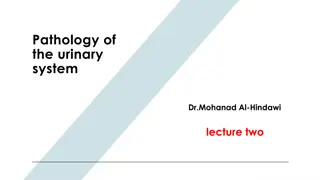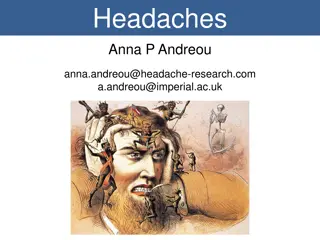Understanding Tumor Classification and Nomenclature in Pathology
This slideshow provides an overview of tumor classification, nomenclature, and key concepts in pathology. It covers the definitions of neoplasm, tumor, and oncology, the classification of tumors into benign and malignant categories, as well as the importance of stroma in tumor behavior. It also explains the similarities between benign and malignant tumors and provides examples of naming benign tumors based on the cell of origin. The content is educational and informative for those studying pathology.
Download Presentation
Please find below an Image/Link to download the presentation.
The content on the website is provided AS IS for your information and personal use only. It may not be sold, licensed, or shared on other websites without obtaining consent from the author. Download presentation by click this link. If you encounter any issues during the download, it is possible that the publisher has removed the file from their server.
Presentation Transcript
Classification of Tumors Slides were taken from Dr. Amany Fathaddin, MD Assistant professor- Department of Pathology Group B & A 1styear- 11thMoharruam 1437 Osamah T. Khojah 0555485892, asd@ksu.edu.sa
Objectives Define the terms: neoplasm, tumor and oncology. Classify tumors into benign and malignant. Understand the concepts governing the classification of tumors and their nomenclature. Define hamartoma, teratoma, choristoma and heterotropic rest.
General Definition General Definition Neoplasia means new growth, Neoplasm is often referred to as a tumor. Oncology (Greek oncos = tumor) is the study of tumors or neoplasms.
Classification of Tumors Benign when its microscopic and gross characteristics are considered relatively innocent, implying that it will remain localized, it cannot spread to other sites, and it is generally amenable to local surgical removal; the patient generally survives. Malignant implies that the lesion can invade and destroy adjacent structures and spread to distant sites (metastasize) to cause death.
Similarity Similarity All tumors, benign and malignant, have two basic components: 1. Clonal neoplastic cells that constitute their parenchyma. 1. Reactive stroma made up of connective tissue, blood vessels, and variable numbers of macrophages and lymphocytes.
Important of Stroma Important of Stroma Although the neoplastic cells largely determine a tumor's behavior and pathologic consequences, their growth and evolution is critically dependent on their stroma. An adequate stromal blood supply is requisite for the tumor cells to live and divide. The nomenclature of tumors and their biologic behavior are based primarily on the parenchymal component.
Benign Tumors Benign Tumors In general, benign tumors are designated by attaching the suffix - oma to the cell of origin. Tumors of mesenchymal cells generally follow this rule. For example, a benign tumor arising in fibrous tissue is called a fibroma, whereas a benign cartilaginous tumor is a chondroma. Adenoma is applied to a benign epithelial neoplasm derived from glands, although they may or may not form glandular structures.
Benign Tumors Benign Tumors Benign epithelial neoplasms producing microscopically or macroscopically visible finger-like or warty projections from epithelial surfaces are referred to as papillomas. Those that form large cystic masses, as in the ovary, are referred to as cystadenomas. Some tumors produce papillary patterns that protrude into cystic spaces and are called papillary cystadenomas. Polyp is a mass that projects above a mucosal surface produces a macroscopically visible projection above a mucosal surface .
Malignant Tumors Malignant Tumors Malignant tumors arising in mesenchymal tissue are usually called sarcomas . Malignant neoplasms of epithelial cell origin, derived from any of the three germ layers, are called carcinomas. Squamous cell carcinoma would denote a cancer in which the tumor cells resemble stratified squamous epithelium. adenocarcinoma denotes a lesion in which the neoplastic epithelial cells grow in glandular patterns.
Malignant Tumors Malignant Tumors Sometimes the tissue or organ of origin can be identified, as in the designation of renal cell adenocarcinoma. Not infrequently, however, a cancer is composed of undifferentiated cells of unknown tissue origin, and must be designated merely as an undifferentiated malignant tumor.
Malignant Tumors Malignant Tumors In many benign and malignant neoplasms, the parenchymal cells bear a close resemblance to each other, as though all were derived from a single cell. However, Divergent differentiation of a single neoplastic clone along two lineages creates what are called mixed tumors. The best example of this is the mixed tumor of salivary gland origin. These tumors contain epithelial components scattered within a myxoid stroma that sometimes contains islands of cartilage or bone . All these elements, it is believed, arise from a single clone capable of giving rise to epithelial and myoepithelial cells; thus, the preferred designation of these neoplasms is pleomorphic adenoma.
Teratoma Teratoma Teratoma, is a special type of mixed tumor that contains recognizable mature or immature cells or tissues representative of more than one germ cell layer and sometimes all three. Originate from totipotential cells such as those normally present in the ovary and testis and sometimes abnormally present in sequestered midline embryonic rests. Such cells have the capacity to differentiate into any of the cell types found in the adult body. When all the component parts are well differentiated, it is a benign (mature) teratoma; when less well differentiated, it is an immature, potentially or overtly, malignant teratoma.
Critical Exceptions Critical Exceptions Benign-sounding designations such as lymphoma, melanoma, mesothelioma, and seminoma have been used for certain malignant neoplasms.
Critical Exceptions Critical Exceptions Hamartomas present as disorganized but benign-appearing masses composed of cells indigenous to the particular site. For example, pulmonary chondroid hamartoma contains islands of disorganized, but histologically normal cartilage, bronchi, and vessels. Traditionally been considered developmental malformations, but some genetic studies have shown the presence of acquired translocations, suggesting a neoplastic origin.
Critical Exceptions Critical Exceptions Choristoma is a congenital anomaly consisting of a heterotopic rest of cells. For example, a small nodule of well-developed and normally organized pancreatic tissue may be found in the submucosa of the stomach, duodenum, or small intestine. It has usual trivial significance.
Summary Although the terminology of neoplasms is regrettably not simple, a firm grasp of the nomenclature is important because it is the language by which the nature and significance of tumors are categorized. Remember the exceptions
Pathology Pathology Fellowship of RCPA for Medical Graduates (apart from diplomas): Anatomical Pathology: (SP/HP), (in NA other clinical pathology). Chemical Pathology (BC, MC, ). Clinical Pathology. Forensic Pathology. General Pathology. Genetic Pathology. Haematology. Immunopathology. Microbiology.
Hematology & Immunology Hematology & Immunology Clinical: Medicine or Pediatric. Pathology: NA or UK/AU, Residency, PhD. Research: transitional/basic
KSF Pathology Programs KSF Pathology Programs Hematopathology & Blood Transfusion: Bone Marrow report: Leukemia & some lymphoma and others. Peripheral blood smear and other routine hematology lab (core lab): cytology & HE. Coagulation tests and anti-coagulant clinic: Transfusion Medicine & cellular therapy in future. Laboratory administration and quality management.
Properties of Benign and Malignant Neoplasm Properties of Benign and Malignant Neoplasm Slides were taken from Dr. Amany Fathaddin, MD Assistant professor- Department of Pathology Group B & A 1styear- 12thMoharruam 1437 Osamah T. Khojah 0555485892, asd@ksu.edu.sa
Objectives Objectives Define the terms: differentiation and anaplasia. Identify the morphological changes that differentiate between benign and malignant tumors. Understand the terms metaplasia, dysplasia and carcinoma in situ. Compare between benign and malignant tumors in terms of differentiation, rate of growth, local invasion and metastases. List the pathways by which malignant tumors spread.
How to differentiate There are four fundamental features by which benign and malignant tumors can be distinguished: 1. Differentiation and anaplasia. 2. Rate of growth. 3. Local invasion. 4. Metastasis.
Differentiation and Anaplasia Differentiation and Anaplasia Differentiation and anaplasia are characteristics seen only in the parenchymal cells that constitute the transformed elements of neoplasms. The differentiation of parenchymal tumor cells refers to the extent to which they resemble their normal forebears morphologically and functionally.
Differentiation and Anaplasia Differentiation and Anaplasia Benign neoplasms are composed of well-differentiated cells that closely resemble their normal counterparts. A lipoma is made up of mature fat cells laden with cytoplasmic lipid vacuoles a chondroma is made up of mature cartilage cells that synthesize their usual cartilaginous matrix In well-differentiated benign tumors, mitoses are usually rare and are of normal configuration.
Leiomyoma Lipoma
Differentiation and Anaplasia Differentiation and Anaplasia Malignant neoplasms are characterized by a wide range of parenchymal cell differentiation, from well differentiated to completely undifferentiated. Between the two extremes lie tumors loosely referred to as moderately well differentiated.
Differentiation and Anaplasia Differentiation and Anaplasia The stroma carrying the blood supply is crucial to the growth of tumors but does not aid in the separation of benign from malignant ones. The amount of stromal connective tissue does determine the consistency of a neoplasm. Certain cancers induce a dense, abundant fibrous stroma (desmoplasia), making them hard, so-called scirrhous tumors.
Differentiation and Anaplasia Differentiation and Anaplasia Malignant neoplasms that are composed of undifferentiated cells are said to be anaplastic. Anaplasia: Lack of differentiation, is considered a hallmark of malignancy.
Anaplastic cells Anaplastic cells Marked pleomorphism variation in size and shape. The nuclei are extremely hyperchromatic (dark-staining) and large resulting in an increased nuclear-to-cytoplasmic ratio that may approach 1:1 instead of the normal 1 : 4 or 1 : 6. Giant cells that are considerably larger than their neighbors may be formed and possess either one enormous nucleus or several nuclei. Anaplastic nuclei are variable and bizarre in size and shape. The chromatin is coarse and clumped, and nucleoli may be of astounding size. Mitoses often are numerous and distinctly atypical; tripolar or quadripolar mitotic figures. They lose normal polarity: fail to develop recognizable patterns of orientation to one another.
Differentiation and Anaplasia Differentiation and Anaplasia The more differentiated the tumor cell, the more completely it retains the functional capabilities of its normal counterparts. Some cancers may elaborate fetal proteins not produced by comparable cells in the adult. Cancers of nonendocrine origin may produce so-called ectopic hormones. the more rapidly growing and the more anaplastic a tumor, the less likely it is to have specialized functional activity.
Differentiation and Anaplasia Differentiation and Anaplasia Metaplasia. Dysplasia is encountered principally in epithelial lesions. It is a loss in the uniformity of individual cells and in their architectural orientation. Dysplastic cells exhibit considerable pleomorphism and often possess hyperchromatic nuclei that are abnormally large for the size of the cell. Mitotic figures are more abundant than usual and frequently appear in abnormal locations within the epithelium.
Differentiation and Anaplasia Differentiation and Anaplasia The term dysplasia is not synonymous with cancer; mild to moderate dysplasias that do not involve the entire thickness of the epithelium sometimes regress completely, particularly if inciting causes are removed.
Carcinoma in situ Carcinoma in situ When dysplastic changes are marked and involve the entire thickness of the epithelium, a pre invasive stage of cancer.
Rate of Growth Most benign tumors grow slowly, and most cancers grow much faster, eventually spreading locally and to distant sites (metastasizing) and causing death. T here are many exceptions to this generalization, however, and some benign tumors grow more rapidly than some cancers.
Rate of Growth The rate of growth of malignant tumors usually correlates inversely with their level of differentiation. Poorly differentiated tumors tend to grow more rapidly than do well- differentiated tumors. However, there is wide variation in the rate of growth. Some grow slowly for years and then enter a phase of rapid growth, signifying the emergence of an aggressive subclone of transformed cells. Others grow relatively slowly and steadily. Rapidly growing malignant tumors often contain central areas of ischemic necrosis, because the tumor blood supply, derived from the host, fails to keep pace with the oxygen needs of the expanding mass of cells.
Rate of Growth Cancer Stem Cells and Lineages The continued growth and maintenance of many tissues that contain short-lived cells, such as the formed elements of the blood and the epithelial cells of the gastrointestinal tract and skin, require a resident population of tissue stem cells that are long-lived and capable of self-renewal. Cancers are immortal and have limitless proliferative capacity, indicating that like normal tissues, they also must contain cells with stemlike properties. The cancer stem cell hypothesis posits that, in analogy with normal tissues, only a special subset of cells within tumors has the capacity for self-renewal. The concept of cancer stem cells has several important implications. Most notably, if cancer stem cells are essential for tumor persistence, it follows that these cells must be eliminated to cure the affected patient. Thus, the limited success of current therapies could be explained by their failure to kill the malignant stem cells that lie at the root of cancer






